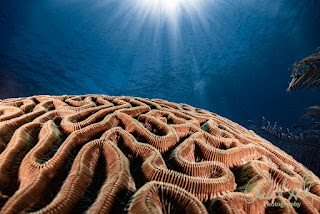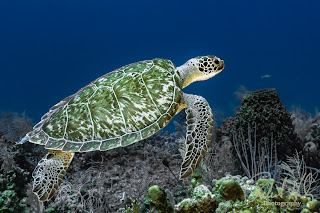10 Essential Lightroom Tips for Underwater Photo Processing
As a Professional Underwater Photographer working with new divers and photographers every week here in Roatan, Honduras, at Turquoise Divers, I get asked many questions. One that I would like to focus on this week, is for those photographers that are either not yet using post-processing or have just started using it. The thing with post-processing is that it can take almost any photograph and make it go from just OK to "Wow". Of course, the more time you spend using these tools the more you can make the photos "POP". Over the last 6+ years here as the Photography Pro at Turquoise Divers, I have now shot over 1 million (>1,000,000) underwater photos and imported them into Adobe Lightroom for processing. Now not all of them do I use or end up on my website, but I sure have learned a lot and have watched how post-processing has changed with all the new and improved tools.
Just a little background on myself for clarification: I started my Underwater Photography journey back in the late 70s when everything was done using negatives or slide film in very basic cameras. We had to process our pictures either through a film developer company or do it ourselves using tools like E6 slide processing. Over the years I went from dogging & burning during the development of my prints using film technology (long and slow process) to digital cameras and Adobe Lightroom/Photoshop for post-processing (much faster and easier).
So with that all said, let us look at what I believe to be the top 10 essential Lightroom Tips.
Capturing the beauty beneath the waves is a unique and rewarding challenge, and post-processing plays a crucial role in bringing your underwater images to life. This guide explores the top ten Lightroom tips for beginners in underwater photo processing, revealing the secrets to enhancing colors, clarity, and vibrancy.
1. White Balance Wizardry
Underwater environments are notorious for distorting colors due to water's absorption of light. Start your post-processing journey by addressing this issue with precise white balance adjustments. Use Lightroom's eyedropper tool on a neutral grey or white area in your image to neutralize the color temperature. This simple step reveals the true colors of your underwater scene, making your images more vibrant and authentic.
2. Dive into Dehaze
The underwater world often presents challenges like haziness caused by water particles. The Dehaze tool in Lightroom can be your secret weapon. Gradually increase the Dehaze slider to cut through the water's murkiness, unveiling sharper details and adding a sense of depth to your images. However, exercise caution to avoid overdoing it, as excessive dehazing can lead to unnatural-looking results.
3. Master the Tone Curve
The Tone Curve is a versatile tool for adjusting the contrast and luminosity of your images. Create an 'S' curve to enhance mid-tones and add a touch of drama to your underwater photos. This curve helps define your subject, bringing out intricate details and providing a more dynamic and visually appealing result.
4. Saturation Sensation
Underwater shots often benefit from a boost in saturation to bring out the vibrant colors that might be subdued in the depths. Adjust the saturation levels selectively, focusing on specific color ranges to avoid over-saturation. This careful approach ensures that your images pop with brilliance while maintaining a natural and pleasing appearance.
5. Go Under the Gradient
Underwater scenes may suffer from uneven lighting due to water depth and angle. Graduated filters in Lightroom come to the rescue. Use them to address exposure imbalances gradually, correcting lighting issues and ensuring a harmonious look throughout your image.
6. Perfecting the Profile
Lightroom profiles offer different starting points for color and tone adjustments. Experiment with various profiles to find one that complements the underwater scene. Adobe provides camera-matching profiles that closely mimic in-camera color rendering, giving you a solid foundation for further edits.
7. Spot Removal Precision
Unwanted elements like backscatter or debris are common in underwater photography. Lightroom's Spot Removal tool is your go-to for eliminating these distractions. Carefully select a source area that matches the surrounding water, ensuring a seamless removal process without leaving noticeable artifacts.
8. Clarity for Definition
Enhance the clarity of your underwater images to bring out fine details and textures. A subtle increase in clarity can make your subject stand out without compromising the natural feel of the underwater scene. Strike a balance to avoid an overly gritty or unrealistic appearance.
9. Noise Reduction Nirvana
Underwater photography at higher ISOs can introduce noise, especially in shadow areas. Tackle this issue with the Noise Reduction tool. Find the sweet spot between reducing noise and preserving image sharpness, ensuring a clean and polished look in your final photos.
10. Export with Purpose
As you finalize your underwater masterpiece, choose the right export settings to preserve image quality. Consider the platform where your photos will be displayed and adjust the resolution accordingly. Use the sharpening settings to optimize the image for its intended destination, whether it's a digital portfolio or print.
By mastering these Lightroom tips, you'll unlock some great potential of your underwater photographs, transforming them into captivating visual narratives that showcase the wonders beneath the waves. Dive in, experiment, and let your creativity flow as you bring the underwater realm to the surface through photo processing.
Let me assist you in your underwater photographic journey with my upcoming online training course, which I will be announcing soon. If you are keen on acquiring more knowledge about it, kindly email me at bob@robertherb.com. You can also visit my website (Robert Herb Photography) to view some of my exemplary work.
I am eagerly anticipating your valuable feedback and suggestions.
Sincerely,
Bob Herb




Comments
Post a Comment
Please let me know your comments.